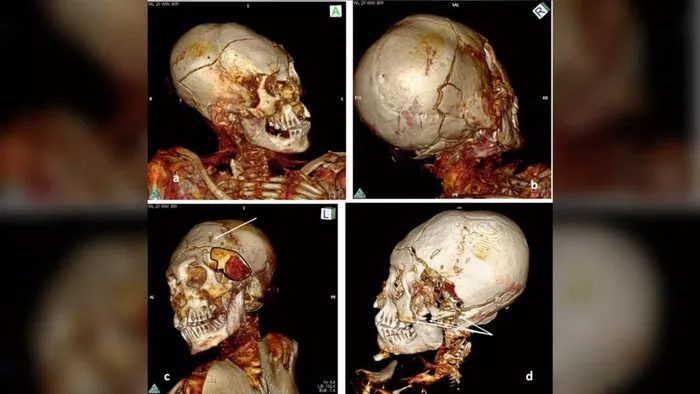About 1,000 years ago, two men in South America may have been brutally murdered—one stabbed in the back and the other suffering a severe neck injury, according to a new analysis of their mummies.
A research team scanned three mummified bodies from Chile and Peru to uncover clues about how they died. The researchers revealed that one male victim had been struck on the head and stabbed in the back, while another man may have died from a “major injury” to the neck, including a dislocation.

3D CT scan of the skull of one of the South American mummies in the new study.
The study adds further evidence of violence in prehistoric human societies and highlights how mummified remains can hold lost secrets that bones alone cannot preserve. Both the stab wounds and the neck injury from the dislocated neck would go unnoticed in skeletal remains.
Co-author of the study, Andreas Nerlich, a professor of pathology at the Munich Bogenhausen Clinic in Germany, stated: “The types of injuries we found would not be detectable if these human remains were only skeletons.”
The human body can be naturally preserved in dry, cold, or otherwise harsh environments, as these conditions inhibit the decomposition process that typically destroys soft tissues and organs. In this case, researchers studied mummies preserved in the very dry environment of South America, which are held in museums in Germany and Switzerland.
Radiocarbon dating revealed that the mummies are between 740 and 1,120 years old, meaning they predate the Spanish colonial period.
One male mummy may originate from the Arica culture in what is now northern Chile. He was buried with fishing tools, suggesting he might have come from a fishing community. The other two mummies, one male and one female, likely come from the Arequipa region, now southwestern Peru, and were buried with materials made from cotton and the hair of llamas or alpacas, as well as viscachas, a type of rodent in the chinchilla family.
The researchers employed computed tomography (CT) scanning to create virtual 3D reconstructions of the bodies, revealing previously hidden details about their deaths. According to the study, while the female mummy died of natural causes, both male mummies died from intentional violence.
Other mummified remains may also have histories waiting to be revealed through modern reconstruction and scanning techniques. “There are dozens of South American mummies that could reveal much from an investigation similar to the one conducted here,” Nerlich said.





















































